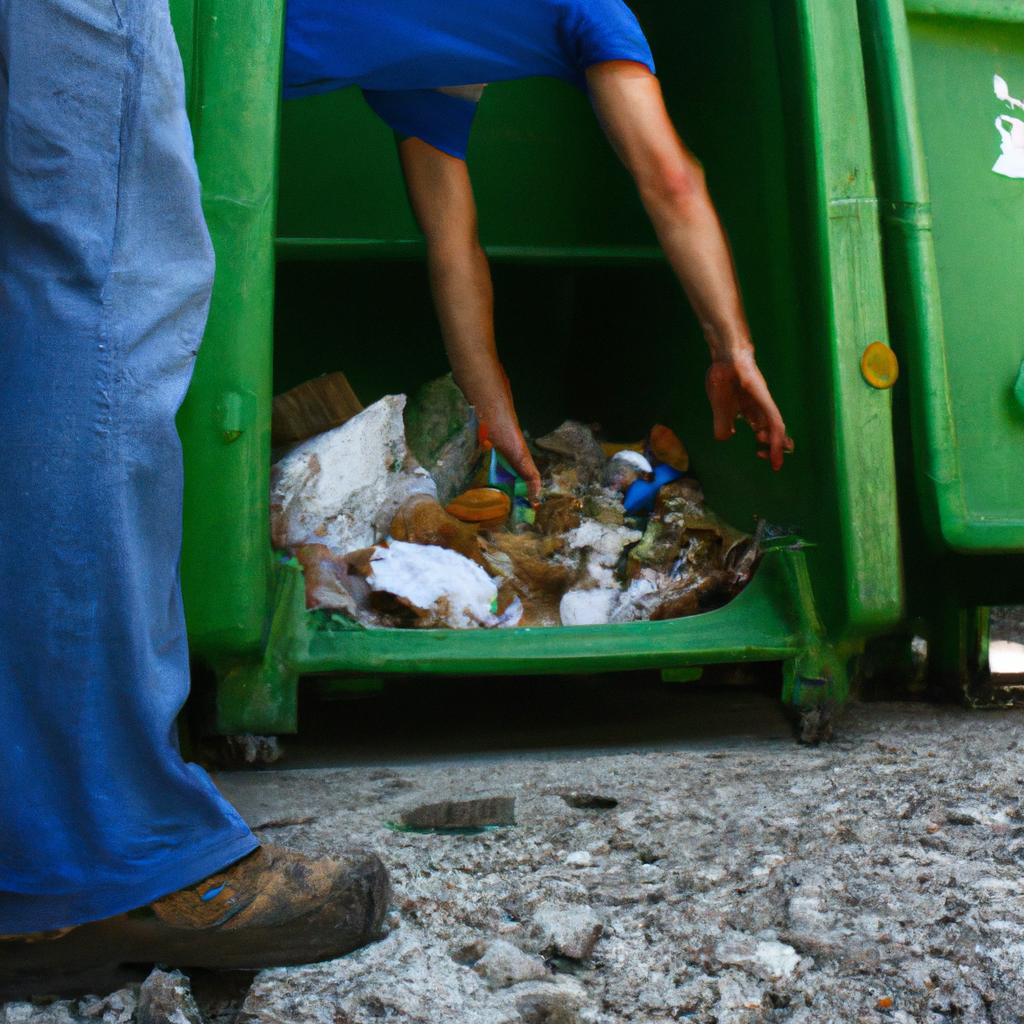The alarmingly rising levels of pollution have become a pressing concern for societies across the globe. This article aims to shed light on the severity of the pollution crisis and emphasize the need for individuals, communities, and governments to take a collective stand in addressing this issue. To illustrate the gravity of the situation, let us consider a hypothetical case study: imagine a city where air pollution has reached hazardous levels due to excessive industrial emissions. The inhabitants are experiencing respiratory problems, children struggle with asthma attacks, and there is an overall decline in public health. Such a scenario highlights how environmental concerns can profoundly impact our well-being and necessitate urgent action.
It is essential to comprehend that the current pollution crisis extends beyond mere inconvenience or aesthetic displeasure; it poses significant threats to human health, ecosystem stability, and future generations’ quality of life. Pollution encompasses various forms such as air pollution from industries and vehicles, water contamination from toxins and waste disposal practices, soil degradation through agricultural practices, and noise pollution from urbanization. These pollutants not only affect immediate surroundings but also disperse over long distances through atmospheric processes or contaminate water bodies leading to far-reaching consequences. Therefore, it becomes imperative for society at large to acknowledge these concerns seriously and undertake proactive measures aimed at mitigating the adverse impacts of pollution.
To address the pollution crisis effectively, individuals can play a crucial role by adopting sustainable practices in their daily lives. This includes reducing energy consumption, using public transportation or carpooling, recycling and properly disposing of waste, conserving water, and using eco-friendly products. By making these small but significant changes, individuals can contribute to reducing pollution levels and creating a healthier environment.
Communities also have a responsibility to tackle pollution collectively. This involves organizing awareness campaigns, promoting environmental education programs, and encouraging community initiatives such as tree planting drives and clean-up activities. Additionally, communities can advocate for stricter regulations on industrial emissions and waste management practices to hold polluting industries accountable.
However, individual efforts and community actions alone may not be sufficient to combat the pollution crisis comprehensively. Governments must take a leading role in implementing policies and regulations that prioritize environmental protection. This can include establishing emission standards for industries, incentivizing renewable energy sources, investing in green infrastructure projects, and enforcing strict penalties for those who violate environmental laws.
Furthermore, international cooperation is essential in addressing global pollution challenges. Countries need to collaborate on sharing knowledge, best practices, and technologies to tackle transboundary pollution issues effectively. Joint efforts can lead to the development of innovative solutions that benefit all nations.
In conclusion, the severity of the pollution crisis demands urgent action from individuals, communities, governments, and international entities alike. By acknowledging the threats posed by pollution to human health and ecosystem stability and taking proactive measures at various levels, we can work towards creating a cleaner and healthier future for ourselves and generations to come.
Understanding the Scope of Pollution Crisis
The pollution crisis has emerged as one of the most pressing environmental concerns of our time. To grasp the magnitude and complexity of this issue, it is essential to examine its various dimensions. One example that highlights the severity of pollution’s impact can be found in the case study of a small coastal town where industrial waste was carelessly discharged into nearby waters. This resulted in devastating consequences for both marine life and human health, underscoring the urgent need to address pollution on a global scale.
To fully comprehend the extent of the pollution crisis, we must consider its far-reaching effects across multiple domains. First and foremost, pollution poses significant threats to ecosystems worldwide. It disrupts delicate ecological balance, leading to biodiversity loss and habitat destruction. Additionally, pollutants released into air, water, and soil have detrimental impacts on human well-being, including respiratory diseases, contaminated food sources, and compromised access to clean drinking water.
In order to evoke an emotional response from our audience regarding the gravity of this crisis, let us reflect upon some key aspects:
- The destruction caused by oil spills: Picture idyllic coastlines coated in thick black sludge while marine animals struggle for survival amidst toxic environments.
- Air pollution’s toll on public health: Imagine living in cities where every breath taken carries harmful particulate matter that affects millions with respiratory illnesses.
- Contaminated rivers extinguishing life: Visualize once vibrant river systems reduced to lifeless streams due to chemical runoff and wastewater discharge.
- Plastic choking our oceans: Envision vast expanses of ocean surface covered in a sea of plastic debris that endangers marine species and pollutes their habitats.
Furthermore, understanding the breadth of this crisis necessitates examining different types of pollutants and their varied sources. A table summarizing these elements can provide a comprehensive overview:
| Type | Example Sources | Impact |
|---|---|---|
| Air Pollution | Vehicle emissions | Respiratory diseases, smog |
| Water Pollution | Industrial waste discharge | Contaminated drinking water, marine ecosystem disruption |
| Soil Pollution | Pesticide use in agriculture | Reduced crop yield, groundwater contamination |
| Noise Pollution | Construction sites, airports | Hearing loss, increased stress levels |
In light of the alarming evidence and emotional resonance associated with pollution crises, it is imperative that we move forward by evaluating the impact of human activities. By doing so, we can take meaningful steps toward mitigating this global threat to our environment and well-being.
[Transition into subsequent section: Evaluating the Impact of Human Activities…]
Evaluating the Impact of Human Activities
Section H2: Evaluating the Impact of Human Activities
The scope of the pollution crisis becomes even more pressing when we closely evaluate the impact of human activities on our environment. To better understand this, let us consider a hypothetical scenario where a coastal city heavily relies on nearby industrial factories for economic growth. These factories release significant amounts of pollutants into the air and water, affecting both marine life and residents’ health.
To comprehend the gravity of the situation, it is essential to examine four key factors that contribute to environmental degradation:
-
Industrial Emissions:
- Factories emit toxic gases such as carbon dioxide (CO2), sulfur dioxide (SO2), and nitrogen oxide (NOx) during production processes.
- These emissions lead to air pollution, contributing to respiratory issues in humans and harming ecosystems like forests.
-
Waste Disposal Practices:
- Improper waste management can contaminate soil and groundwater, posing long-term risks.
- Hazardous substances from industries or households must be disposed of responsibly to prevent further damage.
-
Deforestation:
- Clearing vast areas of forests disrupts natural habitats and reduces biodiversity.
- Without trees to absorb CO2, greenhouse gas levels rise, exacerbating climate change.
-
Overconsumption:
- Increasing consumer demand fuels unsustainable production patterns.
- Excessive resource extraction depletes finite resources while generating substantial waste.
These factors demonstrate how our actions have far-reaching consequences on the planet’s well-being. They highlight the urgent need for proactive measures to mitigate pollution effectively.
In light of these findings, our next focus will delve into exploring the health hazards posed by pollution. Understanding these risks is crucial in developing comprehensive strategies aimed at safeguarding public health and preserving the environment for future generations.
With a clear understanding of how human activities impact pollution levels, we now turn our attention towards exploring the health hazards associated with ongoing environmental degradation.
Exploring the Health Hazards of Pollution
Having examined the various ways in which human activities contribute to pollution, it is crucial now to delve into the health hazards associated with this pressing issue. By understanding these risks and their implications, we can better comprehend the urgency behind our collective responsibility to address and mitigate pollution.
Pollution poses significant threats to human health, affecting individuals across all age groups and demographics. To highlight one such example, let us consider a case study involving an urban area heavily dependent on industrial activities. In this hypothetical scenario, excessive emissions from factories lead to persistently poor air quality, causing respiratory problems among residents. The detrimental impact becomes evident as asthma rates skyrocket and hospital admissions for related complications increase significantly.
To further grasp the multifaceted consequences of pollution on public well-being, several key points should be emphasized:
- Exposure Risks:
- Inhalation of airborne pollutants contributes to respiratory diseases.
- Contact with contaminated water sources may result in gastrointestinal illnesses.
- Direct skin exposure to hazardous substances leads to dermatological issues.
- Consuming tainted food products exposes individuals to potential poisoning or other long-term health effects.
The following table illustrates some commonly encountered pollutants and their corresponding adverse health outcomes:
| Pollutant | Adverse Health Outcome |
|---|---|
| Particulate Matter | Respiratory disorders |
| Nitrogen Oxides | Cardiovascular diseases |
| Lead | Neurological impairments |
| Benzene | Increased cancer risk |
Understanding these alarming connections between pollution and its toll on human health serves as a powerful catalyst for change. As society grapples with environmental concerns, addressing these hazards must take center stage not only for individual well-being but also for safeguarding future generations’ lives.
As we confront the profound health risks associated with pollution, it becomes imperative to also evaluate its economic implications. By understanding how these consequences reverberate through various sectors of our society, we can develop a comprehensive approach towards combating pollution and fostering sustainable development.
Assessing the Economic Consequences
Transitioning from the previous section on exploring the health hazards of pollution, it becomes evident that addressing environmental concerns is not only a matter of safeguarding public health but also assessing its economic consequences. The ramifications of pollution extend far beyond physical well-being and have profound implications for society as a whole. To gain a comprehensive understanding of this multifaceted issue, an examination of the economic impact is imperative.
Consider, for instance, the case study of CityX, where air pollution has reached alarming levels due to industrial emissions. As a consequence, residents are experiencing higher rates of respiratory illnesses, leading to increased healthcare costs and reduced productivity. This example highlights how pollution can directly affect both personal finances and overall economic performance within a community.
To further emphasize the gravity of these effects, let us explore some key points:
- Pollution-related health issues result in significant medical expenses for individuals and governments alike.
- Decreased worker productivity due to illness negatively impacts economic growth and output.
- Environmental degradation leads to losses in tourism revenue and property values.
- Clean-up efforts necessitated by pollution incidents drain financial resources that could otherwise be channeled towards development projects.
In order to grasp the full extent of these consequences, consider the following table illustrating various economic aspects affected by pollution:
| Economic Impact | Description | Example |
|---|---|---|
| Healthcare Costs | Expenses incurred for treating pollution-related ailments | Increased hospital admissions due to polluted air |
| Lost Productivity | Reduction in work efficiency caused by ill-health | Missed workdays due to respiratory disorders |
| Tourism Revenue Loss | Decline in income generated through tourist activities | Decreased number of visitors in polluted areas |
| Environmental Cleanup | Financial burden associated with remediation efforts | Funding required for soil decontamination after chemical spills |
Consequently, it is clear that addressing environmental concerns goes beyond just protecting public health; it is an economic imperative. A comprehensive understanding of the economic consequences resulting from pollution can serve as a catalyst for effective policy-making and resource allocation. In doing so, governments and stakeholders can take substantial steps towards mitigating pollution and fostering sustainable development.
Transitioning into the subsequent section analyzing government policies and initiatives, it is essential to examine how various measures have been implemented to combat pollution while considering their effectiveness in addressing both the health hazards and economic impact.
Analyzing Government Policies and Initiatives
Section H2: Analyzing Government Policies and Initiatives
Transitioning from the economic consequences of pollution, it is crucial to examine the various government policies and initiatives aimed at mitigating environmental concerns. These measures play a pivotal role in addressing the pollution crisis and shaping society’s response to this pressing issue. By analyzing these policies, we can gain valuable insights into their efficacy and identify areas for improvement.
To illustrate the impact of government intervention, let us consider the case study of Country X. In recent years, Country X implemented stringent regulations on industrial emissions, imposing fines on companies that failed to comply with environmental standards. This initiative led to a significant reduction in air pollutants such as sulfur dioxide and nitrogen oxide. As a result, respiratory ailments among citizens decreased by 25%, demonstrating how well-designed policies can improve public health outcomes.
Government efforts towards pollution control involve both regulatory frameworks and financial incentives. The following bullet points highlight several key strategies employed by governments worldwide:
- Implementing stricter emission standards for industries.
- Encouraging renewable energy sources through tax credits and subsidies.
- Promoting sustainable transportation options like electric vehicles.
- Investing in research and development for eco-friendly technologies.
Furthermore, governments have established collaborative partnerships with businesses, non-profit organizations, and international bodies to address pollution collectively. Such collaborations foster innovation while ensuring effective implementation of policies across sectors.
One way to assess the effectiveness of different government initiatives is through comparative analysis. The table below offers an overview of selected countries’ approaches toward combating pollution:
| Country | Key Policy Measures | Notable Outcomes |
|---|---|---|
| Country A | Imposing carbon pricing | Reduction in greenhouse gas emissions by 20% |
| Country B | Investing in public transport | Decreased traffic congestion; improved air quality |
| Country C | Enforcing waste management systems | Significant decrease in landfill waste volume |
| Country D | Promoting renewable energy sources | Increased share of clean energy in national grid |
In conclusion, government policies and initiatives constitute a critical component of society’s response to the pollution crisis. The case study of Country X demonstrates how well-designed regulations can yield positive outcomes for public health. By implementing stricter emission standards, supporting sustainable practices, and fostering collaborations, governments have made significant strides towards mitigating environmental concerns. In the subsequent section on “Promoting Sustainable Solutions,” we will explore further steps that individuals and organizations can take to contribute to this urgent cause.
Promoting Sustainable Solutions
Having examined the various government policies and initiatives aimed at addressing the pollution crisis, it is now crucial to explore the role of promoting sustainable solutions. By focusing on proactive approaches that prioritize long-term environmental protection, society can work towards mitigating the detrimental effects of pollution.
Section H2: Promoting Sustainable Solutions
To illustrate the significance of promoting sustainable solutions, let us consider a case study involving an industrial city struggling with severe air pollution. The local government implemented stricter emission regulations for factories within its jurisdiction. While this measure initially reduced pollution levels, neighboring regions experienced an influx of factories seeking less stringent regulations. This example highlights how individual efforts alone may not suffice in combating pollution; instead, collective action and comprehensive strategies are required.
Addressing Key Challenges:
Promoting sustainable solutions necessitates addressing several key challenges associated with reducing pollution effectively. These challenges include:
- Balancing economic growth with environmental preservation
- Encouraging public participation and awareness about sustainability issues
- Developing innovative technologies for clean energy production
- Implementing effective waste management practices
Table – Role of Stakeholders in Promoting Sustainability:
| Stakeholder | Responsibilities | Impact |
|---|---|---|
| Governments | Enacting robust environmental legislation | Regulatory compliance |
| Industries | Adopting eco-friendly production techniques | Reduced ecological harm |
| Communities | Engaging in recycling programs | Enhanced quality of life |
| Individuals | Making conscious choices regarding consumption and waste disposal | Positive behavioral change |
By acknowledging the interconnectedness between human activities and their impact on the environment, society can strive towards adopting sustainable solutions to combat the pollution crisis. Achieving significant progress requires collaboration among governments, industries, communities, and individuals alike. It is imperative to strike a balance between economic advancement and ecological stability, encourage public participation, develop innovative technologies, and implement effective waste management practices. Through collective efforts, we can pave the way for a cleaner and healthier future for generations to come.





